In order to produce products in the chemical industry process, various types of mixing are required. The most common types of mixing are liquid-with-liquid mixing, solid-with-liquid mixing, liquid-with-gas mixing, and solid-with-solid mixing.
{tocify} $title={Table of Contents}
Liquid with Liquid Mixing
A propeller or a turbine in a tank is the most commonly used equipment for the operation of liquid with liquid mixing and to some extent liquid with solid mixing.
In liquid-with-liquid mixing, a system may contain liquids with or without solids that are not viscous liquids with or without solids that are of different types but pourable and liquids with solids that form stiff pastes
The usual form of equipment is a vertical tank fitted with an agitator. The height of the vessel ranges from 1.5 - 2 times the diameter. The impeller diameter is usually one-third of the tank diameter.
It should be noted that agitation and mixing are not synonyms. Agitation to the induced motion of the material in a circulatory pattern inside a tank or vessel, while mixing is the random distribution into and through one and another, of 2 or more initially separate phases. Based the objectives of the processing step, liquids are agitated for the following purposes.
1. Liquids miscible blending.
2. Gas dispersing in liquid.
3. Suspending solid particles in liquid to produce uniform required for promoting mass transfer and assuring chemical reactions.
4. Contacting immiscible liquids.
5. Promoting heat transfer between jacket and liquid.
Gases with Liquid in Mixing
This is usually accomplished by spraying a gas under a turbine near the bottom of a cylindrical vessel (reactor). Feeding the gas under a propeller is useless because the flow from the propeller is axial and downward. The equipment which can be used for the said purpose consists of a baffled vertical tank incorporating a flat-blade turbine agitator. The diameter of the turbine is one-third of the tank diameter. The depth of a pool of liquid is equal to the tank diameter.
A sparger is mounted below the impeller with holes on the top. The diameter of the sparger is equal to and less than the diameter of the impeller. The gas is introduced from the top and injected in a pool of liquid in the form of fine bubbles through the sparger as shown in the picture.
Liquids with Solids in Mixing
In situations, where the solids are not too material, the liquid is not viscous, and the amount of solids per unit volume of liquid is not too great, the solids can be suspended in liquids with the help of a flat blade turbine-type agitator.
If any of the above-cited conditions do not hold for carrying out mixing one has to look for a kneading machine or some equipment primarily used for mixing solids with solids.
Mixing of Solids with Solids
Machines as pug mills and mullers can blend solids when they are dry and free-flowing as well as when they are pasty, rubbery, and elastic. These machines are usually when material properties change markedly during the mixing operation.
These are less effective on dry powders than on other materials and are heavier and more powerful than required for free-flowing particulate solids. The lighter machines described here such as ribbon blenders and tumbling mixers are effective for dry powders. The ribbon blenders mix solids by mechanical shuffling while tumbling mixers mix solids by repeatedly lifting and dropping the material and rolling it over.
Take these Notes is, for Orginal Sources: Unit Operations-II, KA Gavhane


